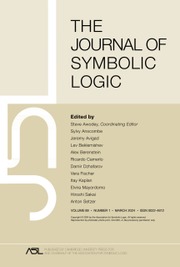Article contents
The uniqueness of envelopes in ℵ0-categorical, ℵ0-stable structures
Published online by Cambridge University Press: 12 March 2014
Extract
The Classification Theorem for ℵ0-categorical strictly minimal sets says that if H is strictly minimal and ℵ0-categorical, either H has in effect no structure at all or is essentially an affine or projective space over a finite field. Zil′ber, in [Z2], showed that if H were a counterexample to this Classification Theorem it would interpret a rank 2, degree 1 pseudoplane. Cherlin later noticed (see [CHL, Appendices 2 and 3], for the proof) that the Classification Theorem is a consequence of the Classification Theorem for finite simple groups. In [Z4] and [Z5], Zil′ber found a quite different proof of the Classification Theorem using no deep group theory.
Meanwhile in [Z3], Zil′ber introduced the notion of envelope in an attempt to prove that no complete totally categorical theory T can be finitely axiomatizable. The idea of the proof was to show that if M is a model of such a T and H ⊆ M is strongly minimal, then an envelope of any sufficiently large finite subset of H is a finite model of any fixed finite subset of T. [Z3] contains an error, which Zil′ber has since corrected (in a nontrivial way).
In [CHL], Cherlin, Harrington and Lachlan used the Classification Theorem to expand and reorganize Zil′ber's work. In particular, they generalized most of his work to ℵ0-categorical, ℵ0-stable structures, proved the Morley rank is finite in these structures, and introduced the powerful Coordinatization Theorem (Theorem 3.1 of [CHL]; Proposition 1.14 of the present paper). They also showed that ℵ0-categorical, ℵ0-stable structures are not finitely axiomatizable using a notion of envelope that is the same as Zil′ber's except in one particularly perverse case; [CHL]'s notion of envelope is used throughout the current paper. Peretyat'kin [P] has found an example of an ℵ1-categorical finitely axiomatizable structure.
Information
- Type
- Research Article
- Information
- Copyright
- Copyright © Association for Symbolic Logic 1984
References
REFERENCES
- 1
- Cited by

